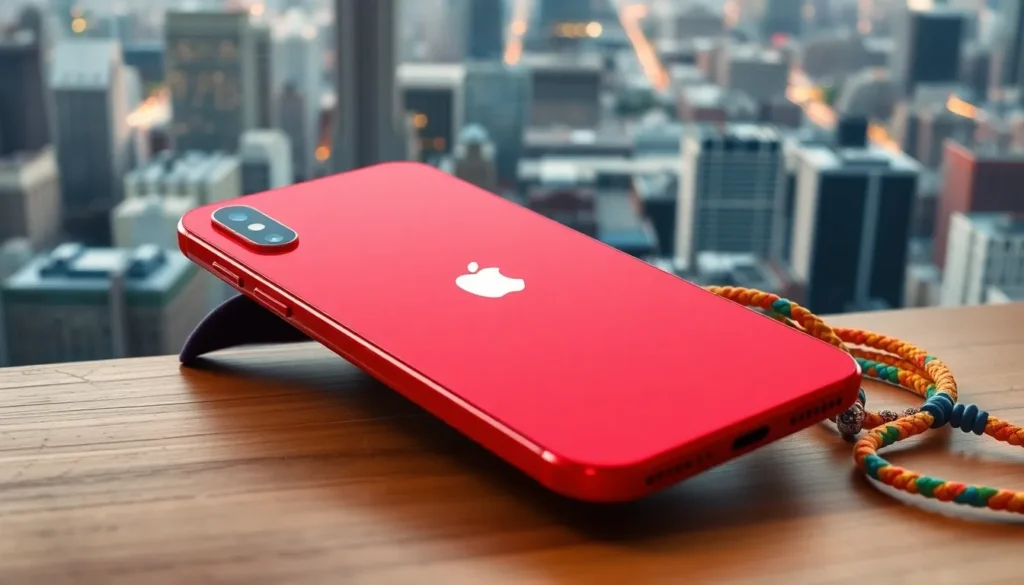Table of Contents
ToggleThe iPhone XR, a beloved device for many, has been a reliable companion since its launch. But as the world races toward lightning-fast 5G connectivity, one question looms large: is this trusty phone ready to join the 5G party? With the speed of a cheetah on espresso, 5G promises to revolutionize how users experience the internet.
Imagine streaming your favorite shows without buffering or downloading apps in the blink of an eye. Sounds dreamy, right? But before you get too excited about the latest tech trends, it’s crucial to find out if the iPhone XR can keep up with the fast-paced world of 5G. Let’s dive into the details and discover if this iconic device can handle the next generation of mobile connectivity.
Overview of iPhone XR
iPhone XR debuted in October 2018, quickly gaining popularity. It features a sleek design with a 6.1-inch Liquid Retina display. Customers appreciate the vibrant colors available, such as coral, blue, yellow, black, white, and Product Red. The device houses the A12 Bionic chip, providing robust performance for daily tasks and gaming.
Battery life stands out with the iPhone XR, offering up to 25 hours of talk time. Photographic capabilities include a 12 MP rear camera, which excels in various lighting conditions. Users enjoy features like Smart HDR and Portrait Mode, enhancing their photography experience.
The device supports Face ID for secure authentication. It’s also equipped with iOS, ensuring access to a diverse range of apps and services. While many users find the 64 GB, 128 GB, and 256 GB storage options sufficient, others may require higher capacities for extensive media collections.
Despite its many strengths, the iPhone XR does not support 5G technology. This limitation affects users wanting to take advantage of faster download speeds and improved connectivity. Although it’s an excellent choice for daily use, those prioritizing 5G capabilities may need to look at newer models, such as the iPhone 12 or later.
5G Technology Explained

5G technology represents the fifth generation of mobile networks, designed to enhance connectivity significantly. This advancement enables faster data transfer speeds, reduced latency, and the capacity to connect a larger number of devices simultaneously.
What is 5G?
5G refers to the latest mobile network technology. It offers remarkable speed, often exceeding 1 Gbps in ideal conditions. Different from its predecessors, this technology relies on a combination of low-band, mid-band, and high-band frequencies. Each frequency plays a pivotal role in creating a balanced network that supports a variety of applications and environments. Enhanced bandwidth and lower latency result in a more responsive experience for users engaged in activities like streaming, gaming, and teleconferencing.
Benefits of 5G Connectivity
5G connectivity presents numerous advantages for users. Significant improvements in speed lead to faster downloads and uploads, enhancing productivity for both work and leisure. Moreover, the technology minimizes latency, making real-time communications smoother. Enhanced capacity allows many devices to connect without degrading performance, which is crucial as smart technologies become more prevalent. Enhanced network reliability ensures stable connections, making it ideal for critical applications, including remote surgery or autonomous vehicles.
iPhone XR Specifications
The iPhone XR, released in October 2018, boasts impressive specifications that contribute to its popularity. It combines sleek aesthetics with robust technology, catering to a diverse range of users.
Network Compatibility
The iPhone XR operates exclusively on 4G LTE networks. It doesn’t support 5G technology, limiting its capacity to leverage the latest advancements in mobile connectivity. Users seeking speedy internet performance may consider newer models. Devices such as the iPhone 12 and later offer 5G compatibility, providing access to improved network speeds. While the XR efficiently handles daily tasks through 4G, it won’t match the enhanced capabilities of 5G-enabled smartphones.
Key Features
Significant features define the iPhone XR’s user experience. A 6.1-inch Liquid Retina display provides vibrant visuals. The A12 Bionic chip delivers powerful performance, making multitasking seamless. With a 12 MP rear camera equipped with Smart HDR and Portrait Mode, photography becomes enjoyable and efficient. Users appreciate the options for storage, available in 64 GB, 128 GB, and 256 GB. Face ID enhances security, enabling easy and secure device access. While these features impress, the absence of 5G may prompt some to explore newer models that meet evolving connectivity needs.
Is the iPhone XR 5G Compatible?
The iPhone XR does not support 5G technology. Users seeking faster internet speeds will find it limited to 4G LTE networks.
Technical Limitations
The A12 Bionic chip allows the iPhone XR to perform efficiently on 4G, but it lacks the hardware necessary for 5G connectivity. Without support for the new standard, users miss out on benefits like lower latency and faster download speeds. 4G provides reliable service for daily tasks but falls short in comparison to the capabilities offered by 5G networks. Consequently, tasks that require high-speed internet may not perform as well on the iPhone XR. For heavy data users, the absence of 5G may translate into longer load times and buffering issues.
Comparison with Other iPhone Models
In contrast to the iPhone XR, models like the iPhone 12 and newer support 5G connectivity. The iPhone 12 features the A14 Bionic chip, which enables it to operate efficiently on both 4G and 5G networks. Users experience significantly faster speeds and improved performance on devices with 5G capabilities. Pricing for newer models may be higher, but the enhanced connectivity aligns better with current technology standards. As 5G networks expand, users may find the latest iPhone models more future-proof for streaming, gaming, and other data-intensive applications.
User Experience with iPhone XR
The iPhone XR provides a solid experience for users reliant on 4G networks.
Performance on 4G Networks
The device operates effectively on 4G LTE networks, delivering satisfactory speeds for most daily tasks. Streaming videos, browsing social media, and handling calls occur without significant interruptions. Users notice that tasks like sending messages and checking emails function smoothly, thanks to the A12 Bionic chip’s robust processing capabilities. Many find that the battery life supports extensive use, offering up to 25 hours of talk time. While data-intensive activities may encounter some limitations, the overall performance remains reliable. Compatibility with various apps enhances its usability across different functions.
Future-Proofing with 5G
The absence of 5G capability in the iPhone XR poses challenges for users looking to stay current with technology advancements. Users seeking faster internet speeds and lower latency may struggle, as newer models support these features. The device lacks the hardware essential for 5G connectivity, making it less suitable for future data demands. In contrast, newer models, like the iPhone 12, incorporate improved technologies, ensuring they remain relevant longer. Users planning extensive media use and application downloads might consider upgrading for better performance and future-proofing. Overall, the limitation of 5G could influence purchasing decisions for those desiring enhanced connectivity options.
The iPhone XR remains a reliable device for users who prioritize a solid performance on 4G networks. Its design and features continue to appeal to many. However its lack of 5G compatibility could be a significant drawback for those who seek faster internet speeds and improved connectivity.
As technology evolves and more applications demand higher data rates the limitations of the iPhone XR may become more pronounced. Users looking for enhanced performance and future-proofing should consider upgrading to newer models that support 5G. While the iPhone XR serves its purpose well for everyday tasks it may not satisfy the needs of data-intensive users in the long run.







